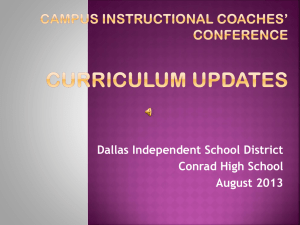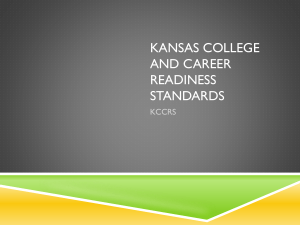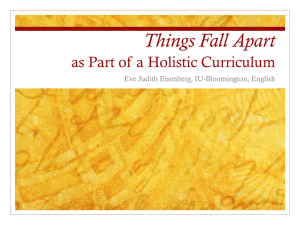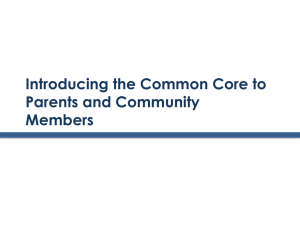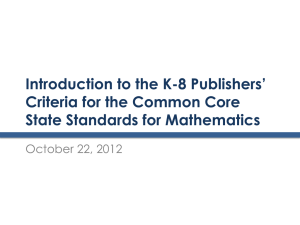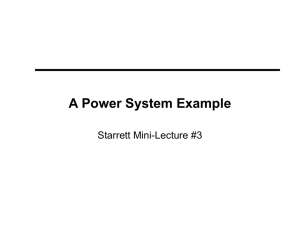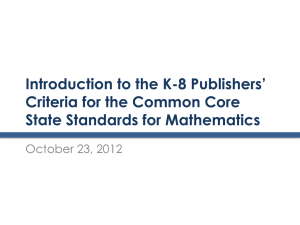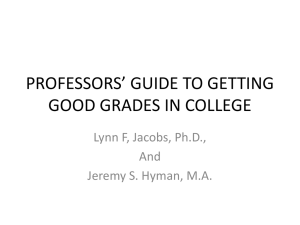Understanding the PA Common Core Updated
advertisement
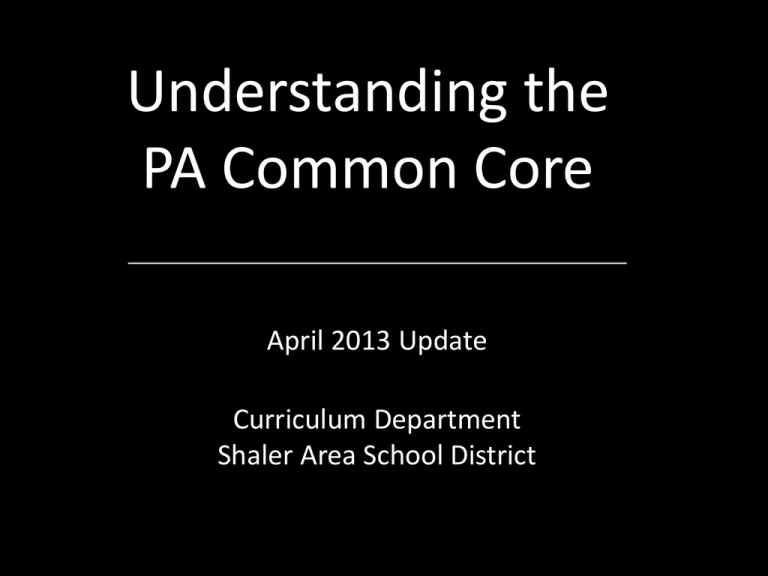
Understanding the PA Common Core April 2013 Update Curriculum Department Shaler Area School District Agenda • Background on Common Core Standards – PA Common Core Standards • Webb’s Depth of Knowledge • English Language Arts – Sample Writing Activity • Mathematics Standards – Sample Mathematics Activity • PACC Transition Plan – Shaler Area SD Transition Plan Background Information • In 2009 the National Governor’s Association and the Council of Chief State School Officers began developing a set of national standards for English Language Arts and Mathematics. • A total of 45 states and the District of Columbia four territories, and the Department of Defense Education Activity have adopted the standards. • States are allowed to add 15% more content to the national standards. • PA adopted the CC standards in 2010 and opted to craft a set of standards now know as the PA common core standards which included the additional 15%. Module 1 English Language Arts Writing Speaking and Listening Depth and Rigor The new PA Common Core Standards (PACC) emphasize depth and rigor using Webb’s Depth of Knowledge (DOK) Levels. 1. Recall- Requires simple recall of such information as a fact, definition, term, or simple procedure. 2. Skill/Concept- Involves some mental skills, concepts, or processing beyond a habitual response; students must make some decisions about how to approach a problem or activity. Keywords distinguishing a Level 2 item include classify, organize, estimate, collect data, and compare data. 3. Strategic Thinking- Requires reasoning planning, using evidence, and thinking at a higher level. 4. Extended Thinking- Requires complex reasoning, planning, developing, and thinking, most likely over an extended time. Cognitive demands are high, and students are required to make connections both within and among subject domains. Overarching Themes • Common Core supports a high degree of rigor and student collaboration. • An emphasis on non-fiction occurs throughout the grades as well as increasing the amount of student reading. • Technology is embedded and emphasizes the use of digital resources. • Speaking and Listening standards are much more specific. • Writing on a daily basis for a variety of purposes is encouraged. • Text complexity is a prominent addition with exemplar texts. – Specificity and scaffolding of standards providing vertical articulation to support text complexity. • Text connections are emphasized throughout grade levels. Reading Informational Text • Students read, understand, and respond to informational text with an emphasis on comprehension, vocabulary acquisition, and making connections among ideas and between texts with a focus on textual evidence. Increased emphasis in non-fiction reading. • When students graduate and go to college and beyond, most reading is non-fiction. • Students must be prepared to read and analyze non-fiction works throughout grades K-12. Science, Social Studies and other subject areas must assist in this increased reading and analysis of non-fiction. We must consistently utilize Science and Social Studies textbooks. • By high school, students should be reading up to 75% non-fiction. Anchor Standards for Reading • • • • • Key Ideas and Details Craft and Structure Integration of Knowledge and Ideas Vocabulary Integration and Use Range of Reading and Level of Text Complexity Foundational Skills K-5 • • • • • Book Handling Print Concepts Phonological Awareness Phonics and Work Recognition Fluency • Thinking is KEY! Range of Reading and Level of Text Complexity • Read and comprehend complex literary and informational texts independently and proficiently. • “…students must read deeply and widely from a broad range of high quality, increasingly challenging literary and informational texts.” • “…when the curriculum is intentionally and coherently structured to develop rich content knowledge within and across grades.” Writing • Students write for different purposes and audiences. Students write clear and focused text to convey a well defined perspective and appropriate content. – – – – – – – – – Informative/Explanatory Opinion/Argumentative Narrative Response to Literature Production and Distribution of Writing Technology and Publication Conducting Research Credibility, Reliability, and Validity of Sources Range of Writing Source: http://static.pdesas.org/content/documents/PA_CC_Standards_PreK-5_ELA.pdf Writing • A shift away from narrative writing and focus more on evidence based writing. • Students must argue based on evidence and reliable sources. • Use evidence from informational texts when writing. • Use grade appropriate grammar, spelling, punctuation, etc. Sample Writing Activity • Owl Moon – Grade 2 • Find a partner who selected the same Student Sample. Using the PA Common Core Grade Level Standards associated with your Student Sample and referencing your Student Sample, list three or more Standards in Column 1 and cite the evidence from the student sample. Research begins in Kindergarten • K – Participate in shared research and writing projects. • 4th – Conduct short research projects that build knowledge through investigation of different aspects of a topic. • 7th – Conduct short research projects to answer a question, drawing on several sources and generating additional related, focused question for future research. • 11th/12th – Conduct short as well as more sustained research projects to answer a question (including a self-generated question) or solve a problem; narrow or broaden the inquiry when appropriate; synthesize multiple sources on the subject, demonstrating understanding of the subject under investigation. Speaking and Listening • Students present appropriately in formal speaking situations, listen critically, and respond intelligently as individuals or in group discussions. – Comprehension and Collaboration – Presentation of Knowledge and Ideas – Integration of Knowledge and Ideas – Conventions of Standard English Source: http://static.pdesas.org/content/documents/PA_CC_Standards_PreK-5_ELA.pdf PACC Transition Guides • Transition Guides are available for: -Math (Grades K-8) -ELA (Grades K-8) • Highlights standards and concepts that require continued emphasis and specific PA Common Core Standard to emphasis for skills. • Available at pdesas.org GRADE 4 PA COMMON CORE STANDARDS TRANSITION GUIDE * CONTINUED EMPHASIS Comprehension Skills (Fiction and Non-Fiction) Vocabulary Development Word Recognition Skills Decoding Skills Fluency Types of Writing Quality of Writing Research Speaking and Listening Conventions of Standard English Technology Literacy SPECIFIC PA COMMON CORE EMPHASIS Increasing reading of non-fiction texts (goal of 50% @ end of Grade 4) (Introduction to ELA: Key Design Considerations) Reading mythology, traditional literature, and multicultural texts (CC.4.R.I.4) (CC.1.3.4.H, CC.1.3.4.K) Comparing point of view across texts (CC.1.2.4.D) (CC.1.3.4.D) Assessing how illustrations/multi-media contribute to text presentation (CC.1.2.4.G) Providing explicit support when drawing inferences (CC.1.2.4.B) (CC.1.2.4.C) Citing reasons and evidence used by the author (CC.1.2.4.H) (CC1.3.4.B) Integrating information on a single topic from two texts (CC.1.2.4.I) (CC.1.5.4.C) Using multiple strategies to determine meaning of unknown words (context clues) (CC.1.1.4.E) (CC.1.2.4.K) (CC.1.3.4.I) Developing vocabulary through the use of dictionaries and thesaurus (CC.1.2.4.K) (CC.1.3.4.I) Incorporating the use of figurative language, word relationships, and nuances to determine word meaning (CC.1.2.4.F, CC.1.3.4.F) Using combined knowledge of all letter/sound correspondence, syllabication patterns, and morphology (CC.1.1.4.D) Connecting fluency explicitly to comprehension (CC.1.1.4.E) Instructing fluency for accuracy, expression, and rate (CC.1.1.4.E) Providing writing activities that that require a response to reading (CC.1.4.4.A) Providing writing activities that require varied time frames for completion (CC.1.4.4.X) Undertaking research projects that build upon comparisons made in text(s) (CC.1.4.4.V) Analyzing and reflecting upon text sources and citing evidence in research (CC.1.4.4.W) Participating in frequent collaborative discussions with diverse partners (CC.1.5.4.A) Posing specific questions that contribute to or enhance group discussions (CC.1.5.4.A) Providing opportunities for structured oral response (e.g., paraphrase, retell, recount) (CC.1.1.4.E) Applying conventions of language to speaking and listening (CC.1.5.4.G) Foundational grammar should be taught in the context of reading, writing, and speaking (CC.1.4.4.F) (CC.1.4.4.L) (CC.1.4.4.R) (CC.1.5.4.G) Using relative pronouns, progressive verb tenses, modal auxiliary, order of adjectives, prepositional phrases, homonyms, and complete sentences (CC.1.4.4.F, CC.1.4.4.L, CC.1.4.4.R) (CC.1.5.4.A) Using keyboarding skills to produce a 1-page piece of writing in a single sitting (CC.1.4.4.U) Module 2 Mathematics Mathematics Standards for Mathematical Practice • Make sense of problems and persevere in solving them. • Reason abstractly and quantitatively. • Construct viable arguments and critique the reasoning of others. • Model with mathematics. • Use appropriate tools strategically. • Attend to precision. • Look for and make use of structure. • Look for and make sense of regularity in repeated reasoning. Mathematics PACC standards for Mathematics will focus on four main areas: 1. Numbers and Operations 2. Algebraic Concepts 3. Geometry 4. Data Analysis and Probability Mathematics Shifts • Focus: Focus strongly where the standards focus. • Coherence: Think across grades, and link to major topics • Rigor: In major topics, pursue conceptual understanding, procedural skill and fluency, and application Source: www.achievethecore.org Shift #1: Focus Strongly where the Standards Focus • Significantly narrow the scope of content and deepen how time and energy is spent in the math classroom. • Focus deeply on what is emphasized in the standards, so that students gain strong foundations. Source: www.achievethecore.org Key Areas of Focus in Mathematics Grade K–2 3–5 Focus Areas in Support of Rich Instruction and Expectations of Fluency and Conceptual Understanding Addition and subtraction - concepts, skills, and problem solving and place value Multiplication and division of whole numbers and fractions – concepts, skills, and problem solving 6 Ratios and proportional reasoning; early expressions and equations 7 Ratios and proportional reasoning; arithmetic of rational numbers 8 Linear algebra Source: www.achievethecore.org Shift #2: Coherence: Think Across Grades, and Link to Major Topics Within Grades • Carefully connect the learning within and across grades so that students can build new understanding on foundations built in previous years. • Begin to count on solid conceptual understanding of core content and build on it. Each standard is not a new event, but an extension of previous learning. Source: www.achievethecore.org Shift #3:Rigor • • The PACC require a balance of: • Solid conceptual understanding • Procedural skill and fluency • Application of skills in problem solving situations Pursuit of all threes requires equal intensity in time, activities, and resources. Source: www.achievethecore.org Solid Conceptual Understanding • Teach more than “how to get the answer” and instead support students’ ability to access concepts from a number of perspectives • Students are able to see math as more than a set of mnemonics or discrete procedures • Conceptual understanding supports the other aspects of rigor (fluency and application) Source: www.achievethecore.org Application • Students can use appropriate concepts and procedures for application even when not prompted to do so. • Teachers provide opportunities at all grade levels for students to apply math concepts in “real world” situations, recognizing this means different things in K-5, 6-8, and high school. • Teachers in content areas outside of math, particularly science, ensure that students are using grade-levelappropriate math to make meaning of and access science content. Source: www.achievethecore.org Fluency • The standards require speed and accuracy in calculation. • Teachers structure class time and/or homework time for students to practice core functions such as singledigit multiplication so that they are more able to understand and manipulate more complex concepts. Source: www.achievethecore.org It’s tough stuff! Grade 4 Sample A teacher asked her students to use estimation to decide if the sum of the problem below is closer to 4,000 or 5,000. 496 + 1,404 + 2,605 + 489 = One student replied that she thinks the sum is closer to 4,000. She used the estimation shown below to support her reasoning. Is the student’s reasoning correct? Use numbers and words to explain why or why not. If the student’s reasoning is not correct, explain how she should have estimated. PACC Timeline • Spring 2013 – Professional Development on PACC • Fall 2013 – Introduction of PACC Aligned Curriculum in ELA and Mathematics • Spring 2015- PSSA’s aligned to PA Common Core given in grades 3-8. – Introduction of a combined Reading and Writing Assessment known as “ELA PSSA” – Pilot Assessment was given in Grades 3-5 this Winter.

